A) Ken doesn't like nachos.
B) Ken prefers nachos over spaghetti.
C) Ken will get more utility from making spaghetti for dinner than nachos.
D) None of these is true.
F) None of the above
Correct Answer

verified
Correct Answer
verified
Multiple Choice
This graph shows three different budget constraints: A,B,and C. 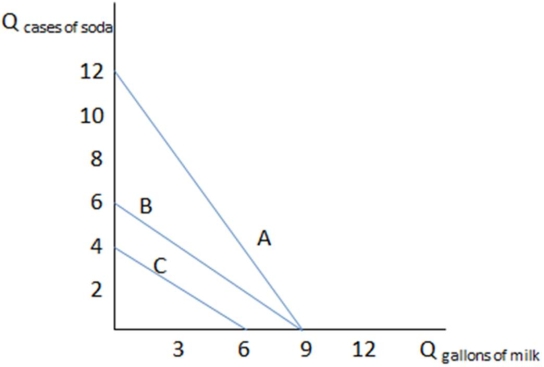 If Bert has budget constraint A in the graph shown,what is his opportunity cost of three gallons of milk?
If Bert has budget constraint A in the graph shown,what is his opportunity cost of three gallons of milk?
A) Twelve cases of soda
B) Eight cases of soda
C) Four cases of soda
D) It is impossible to say without knowing Bert's income.
F) C) and D)
Correct Answer

verified
Correct Answer
verified
Multiple Choice
When a person's income increases:
A) the individual's budget constraint shifts straight out, maintaining the same slope.
B) the individual's budget constraint shifts straight in, maintaining the same slope.
C) the individual's budget constraint rotates out and becomes flatter.
D) the individual's budget constraint rotates in and becomes steeper.
F) All of the above
Correct Answer

verified
Correct Answer
verified
Multiple Choice
Howard has just smoked a cigarette.If he chooses to smoke a second one:
A) he will experience a drop in total utility.
B) he is not acting rationally.
C) he will derive less marginal utility from it than his first.
D) None of these is true.
F) A) and D)
Correct Answer

verified
Correct Answer
verified
Multiple Choice
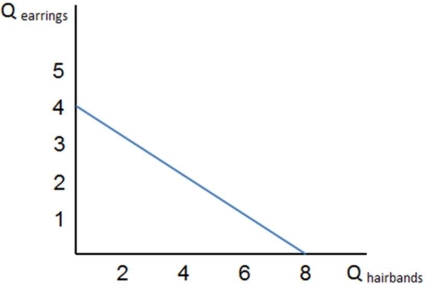 If the graph shown represents Stella's budget constraint,and hairbands cost $4,what must Stella's income to spend on these two items be?
If the graph shown represents Stella's budget constraint,and hairbands cost $4,what must Stella's income to spend on these two items be?
A) $32
B) $16
C) $48
D) Cannot answer this question without more information.
F) None of the above
Correct Answer

verified
Correct Answer
verified
Multiple Choice
When a person's income decreases,the slope of the individual's budget constraint stays the same because:
A) everything is relatively more expensive now.
B) everything is relatively less expensive now.
C) the relative prices of the goods haven't changed.
D) the prices of the goods change in the same proportion.
F) A) and C)
Correct Answer

verified
Correct Answer
verified
Multiple Choice
Dave and Buster play two games of tennis,and then decide to go have lunch.Using the concept of utility to explain their choices,we can conclude that:
A) they each won one game of tennis.
B) the marginal utility from playing a third game must be negative for them.
C) the marginal utility from playing a third game must be less than the marginal utility from having lunch.
D) All of these must be true.
F) A) and C)
Correct Answer

verified
Correct Answer
verified
Multiple Choice
This table shows the different combinations of goods that Jack can consume,given that his income to spend on these two items is $10.  Considering the information in the table shown,if Jack decides to consume bundle D,we can conclude that Jack:
Considering the information in the table shown,if Jack decides to consume bundle D,we can conclude that Jack:
A) still has money left to spend.
B) is not maximizing his utility.
C) could consume more of both goods.
D) All of these are true.
F) A) and D)
Correct Answer

verified
Correct Answer
verified
Multiple Choice
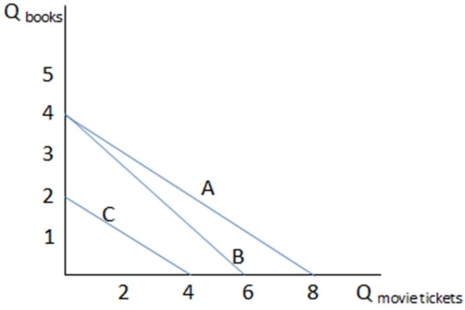 Assume Bill's income to spend on the two goods in the graph shown is $48,and movie tickets cost $8.If Bill's budget constraint is one of the lines in the graph,which one must it be?
Assume Bill's income to spend on the two goods in the graph shown is $48,and movie tickets cost $8.If Bill's budget constraint is one of the lines in the graph,which one must it be?
A) A
B) B
C) C
D) It could be line A or B.
F) B) and D)
Correct Answer

verified
Correct Answer
verified
Multiple Choice
The concept of utility maximization:
A) is solely used to measure an individual's satisfaction with his consumption choices.
B) can be used broadly to think about choices made motivated by satisfaction, envy, status, or kindness.
C) assumes each individual seeks to increase his own personal satisfaction regardless of others.
D) None of these is true.
F) C) and D)
Correct Answer

verified
Correct Answer
verified
Multiple Choice
This table shows the different combinations of goods that Jack can consume,given that his income to spend on these two items is $10.  Considering the information in the table shown,the bundle of goods that will derive the highest total utility for Jack is:
Considering the information in the table shown,the bundle of goods that will derive the highest total utility for Jack is:
A) E.
B) B.
C) C.
D) D.
F) A) and D)
Correct Answer

verified
Correct Answer
verified
Multiple Choice
If Bella eats one piece of pie,she gains a utility of 10.If she continues,a second piece yields a marginal utility of 8,a third will yield a marginal utility of 2,and a fourth piece of pie will yield a marginal utility of 2.We can say:
A) Bella's marginal utility is not diminishing.
B) Bella's total utility will decrease if she eats the third piece of pie.
C) Bella's total utility will be maximized if she eats three pieces.
D) Bella's total utility decreases after the first piece of pie.
F) B) and D)
Correct Answer

verified
Correct Answer
verified
Multiple Choice
Altruism describes:
A) a motive for action in which a person's utility is unaffected when another's utility increases.
B) a motive for action in which a person's utility is decreased when another's utility increases.
C) a motive for action in which a person's utility is increased when another's utility increases.
D) a motive for action in which a person's utility becomes negative when another's utility increases.
F) B) and C)
Correct Answer

verified
Correct Answer
verified
Multiple Choice
Utility is:
A) a way of describing a consumer's wants.
B) only applicable to goods that are purchased.
C) a measure of a consumer's income
D) All of these are true.
F) B) and C)
Correct Answer

verified
Correct Answer
verified
Multiple Choice
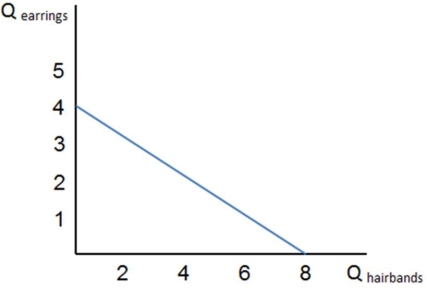 If the graph shown represents Suzi's budget constraint,what can be said about hairbands?
If the graph shown represents Suzi's budget constraint,what can be said about hairbands?
A) They cost twice as much as earrings.
B) They cost half as much as earrings.
C) Suzi likes hairbands more than earrings.
D) Suzi is willing to pay twice as much for hairbands.
F) None of the above
Correct Answer

verified
Correct Answer
verified
Multiple Choice
This table shows the different combinations of goods that Jack can consume,given that his income to spend on these two items is $10.  Considering the information in the table shown,the price of ice cream is:
Considering the information in the table shown,the price of ice cream is:
A) $2 per cone.
B) $1 per cone.
C) diminishing as Jack increases the amount consumed.
D) $5 per cone.
F) C) and D)
Correct Answer

verified
Correct Answer
verified
Multiple Choice
The Golden Rule "Do unto others as you would have done unto you" is an example of the economic concept of:
A) marginal utility.
B) altruism.
C) reciprocity.
D) selfishness.
F) A) and B)
Correct Answer

verified
Correct Answer
verified
Multiple Choice
Quinn's income to spend on either bowling or eating out each month is $100.It costs $10 to bowl for the night and it costs $20 for Quinn to eat at a restaurant.A point on Quinn's budget constraint would be:
A) 4 nights of bowling and 3 trips to the restaurant.
B) 3 nights of bowling and 4 trips to the restaurant.
C) 2 nights of bowling and 5 trips to the restaurant.
D) 10 nights of bowling and 5 trips to the restaurant.
F) A) and D)
Correct Answer

verified
Correct Answer
verified
Multiple Choice
This graph shows three different budget constraints: A,B,and C. 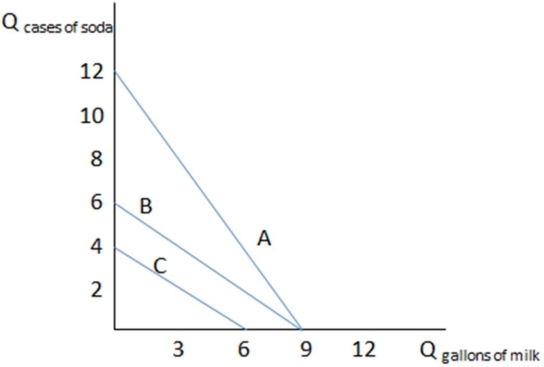 If Gary has budget constraint A,and the price of milk is $3 a gallon,what is Gary's income?
If Gary has budget constraint A,and the price of milk is $3 a gallon,what is Gary's income?
A) $9
B) $27
C) $12
D) Cannot answer this without knowing the price of soda.
F) All of the above
Correct Answer

verified
Correct Answer
verified
Multiple Choice
The substitution effect can be defined as:
A) the change in consumption that results from a change in the relative price of goods.
B) the change in consumption that results from increased effective wealth due to lower prices.
C) the change in consumption that results from increased effective wealth due to getting a raise.
D) the change in income that results from increased effective consumption due to lower prices
F) B) and C)
Correct Answer

verified
Correct Answer
verified
Showing 81 - 100 of 130
Related Exams